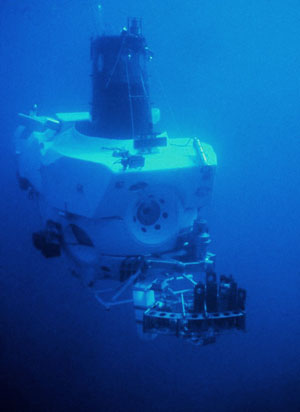|
Home > Ocean > Exploring the Deep > Submersibles
Alvin
Although the U.S. Navy had invested considerable money and resources in the development of the Trieste II, there was dissent within the Navy about the importance of exploring the deep and costs involved. One frustrated Naval expert who was on the side of progress and wanted to see continued expeditions to the deep, was Charles Momsen Jr., Chief of Undersea Warfare at the Office of Naval Research. He eventually convinced the U.S. Naval Offices to commission a highly maneuverable deep submergence vehicle (DSV) that would be capable of mounting undersea rescue missions in the event of another devastating submarine disaster, such as the sinking of the famous Thresher. Momsen worked closely with Al Vine of the Woodshole Oceanographic Institute in Cape Cod. In deference to him, the DSV that was developed out of the U.S. Navy and WHOI partnership came to be called Alvin, a contraction of the name Al Vine, and the name has stuck even today.
Take a virtual tour of the inside cabin of the ALVIN submersible ->
 The Alvin DSV was a streamlined marvel of modern technology that it still in use today. Alvin is not only highly maneuverable, but it also has many adaptations included especially for scientific observation and collection of data and samples. The crew cabin is large enough to fit three people, although two is the usual number. There are several viewing ports (windows), external strobe lights with still and video cameras, as well as remote manipulator arms that can be guided by observers to collect samples and secure them in an exterior basket to bring to the surface. The Alvin is one of a fleet of DSVs that have been developed to explore, catalog, observe and study the deep. Although it was commissioned by the U.S. Navy, it performs primarily as a scientific vessel. Alvin has logged over 3,600 dives into the ocean for over 25,000 hours to an average depth of 2,060 meters. More than 70% of the diving that Alvin has done has been to make scientific observations and measurements in geology, geophysics, and biology. What was the first deep sea submersible? -> The Alvin DSV was a streamlined marvel of modern technology that it still in use today. Alvin is not only highly maneuverable, but it also has many adaptations included especially for scientific observation and collection of data and samples. The crew cabin is large enough to fit three people, although two is the usual number. There are several viewing ports (windows), external strobe lights with still and video cameras, as well as remote manipulator arms that can be guided by observers to collect samples and secure them in an exterior basket to bring to the surface. The Alvin is one of a fleet of DSVs that have been developed to explore, catalog, observe and study the deep. Although it was commissioned by the U.S. Navy, it performs primarily as a scientific vessel. Alvin has logged over 3,600 dives into the ocean for over 25,000 hours to an average depth of 2,060 meters. More than 70% of the diving that Alvin has done has been to make scientific observations and measurements in geology, geophysics, and biology. What was the first deep sea submersible? ->
Woodshole Oceanographic Institute
|
Get Your Degree!
Find schools and get information on the program that’s right for you.
Powered by Campus Explorer
|

